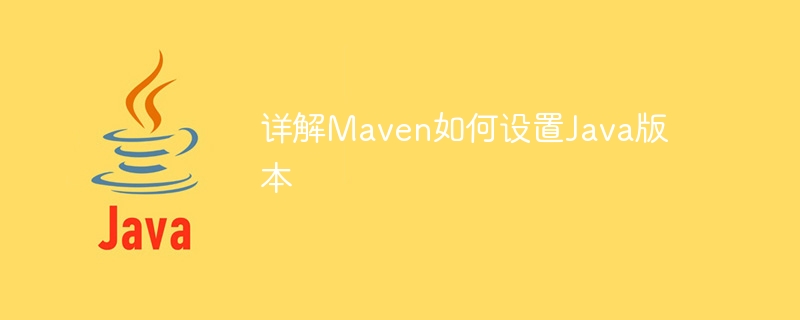Detailed explanation of how Maven sets the Java version

How Maven sets the Java version
Maven is a powerful project management tool for building, dependency management and deployment of Java projects. When using Maven to build a project, you usually need to ensure that the project uses a specific version of Java to ensure compilation and execution compatibility. This article will detail how to set the Java version through Maven and provide specific code examples.
1. Set the Java version in the POM file
The Java version in the Maven project can be set in the pom.xml filemaven-compiler-plugin Plug-in to specify. In the plugin configuration, you can set the source and target parameters to specify the desired Java version. The following is an example configuration example of setting the Java version to 1.8 in the pom.xml file:
<project>
...
<properties>
<maven.compiler.source>1.8</maven.compiler.source>
<maven.compiler.target>1.8</maven.compiler.target>
</properties>
...
<build>
<plugins>
<plugin>
<groupId>org.apache.maven.plugins</groupId>
<artifactId>maven-compiler-plugin</artifactId>
<version>3.8.0</version>
<configuration>
<source>1.8</source>
<target>1.8</target>
</configuration>
</plugin>
</plugins>
</build>
...
</project>In the above configuration, by setting maven.compiler.source and the maven.compiler.target property is 1.8, and source and ## are set in the configuration of the maven-compiler-plugin plugin #target are all 1.8 to ensure that the project is compiled using Java 1.8 version.
pom.xml, you can also specify the Java version used by the Maven project by configuring environment variables. The required Java path can be specified by setting the JAVA_HOME environment variable in the MAVEN_HOME/bin/mvn file. Specific operations include:
- Open the
- MAVEN_HOME/bin/mvn
fileAdd the following code at the beginning of the file:
export JAVA_HOME=/path/to/java-1.8
-Dmaven.compiler.source=1.8 -Dmaven.compiler.target=1.8 parameter after the mvn command. Example:
mvn clean install -Dmaven.compiler.source=1.8 -Dmaven.compiler.target=1.8
pom.xml file, or directly specifying them on the command line, you can ensure that the project is compiled and executed using the specified Java version. It is recommended to choose the most suitable setting method based on actual needs to ensure the stability and compatibility of the project.
The above is the detailed content of Detailed explanation of how Maven sets the Java version. For more information, please follow other related articles on the PHP Chinese website!

Hot AI Tools

Undresser.AI Undress
AI-powered app for creating realistic nude photos

AI Clothes Remover
Online AI tool for removing clothes from photos.

Undress AI Tool
Undress images for free

Clothoff.io
AI clothes remover

AI Hentai Generator
Generate AI Hentai for free.

Hot Article

Hot Tools

Notepad++7.3.1
Easy-to-use and free code editor

SublimeText3 Chinese version
Chinese version, very easy to use

Zend Studio 13.0.1
Powerful PHP integrated development environment

Dreamweaver CS6
Visual web development tools

SublimeText3 Mac version
God-level code editing software (SublimeText3)

Hot Topics
 1378
1378
 52
52
 How does Java's classloading mechanism work, including different classloaders and their delegation models?
Mar 17, 2025 pm 05:35 PM
How does Java's classloading mechanism work, including different classloaders and their delegation models?
Mar 17, 2025 pm 05:35 PM
Java's classloading involves loading, linking, and initializing classes using a hierarchical system with Bootstrap, Extension, and Application classloaders. The parent delegation model ensures core classes are loaded first, affecting custom class loa
 How do I implement multi-level caching in Java applications using libraries like Caffeine or Guava Cache?
Mar 17, 2025 pm 05:44 PM
How do I implement multi-level caching in Java applications using libraries like Caffeine or Guava Cache?
Mar 17, 2025 pm 05:44 PM
The article discusses implementing multi-level caching in Java using Caffeine and Guava Cache to enhance application performance. It covers setup, integration, and performance benefits, along with configuration and eviction policy management best pra
 How can I use JPA (Java Persistence API) for object-relational mapping with advanced features like caching and lazy loading?
Mar 17, 2025 pm 05:43 PM
How can I use JPA (Java Persistence API) for object-relational mapping with advanced features like caching and lazy loading?
Mar 17, 2025 pm 05:43 PM
The article discusses using JPA for object-relational mapping with advanced features like caching and lazy loading. It covers setup, entity mapping, and best practices for optimizing performance while highlighting potential pitfalls.[159 characters]
 How do I use Maven or Gradle for advanced Java project management, build automation, and dependency resolution?
Mar 17, 2025 pm 05:46 PM
How do I use Maven or Gradle for advanced Java project management, build automation, and dependency resolution?
Mar 17, 2025 pm 05:46 PM
The article discusses using Maven and Gradle for Java project management, build automation, and dependency resolution, comparing their approaches and optimization strategies.
 How do I create and use custom Java libraries (JAR files) with proper versioning and dependency management?
Mar 17, 2025 pm 05:45 PM
How do I create and use custom Java libraries (JAR files) with proper versioning and dependency management?
Mar 17, 2025 pm 05:45 PM
The article discusses creating and using custom Java libraries (JAR files) with proper versioning and dependency management, using tools like Maven and Gradle.




